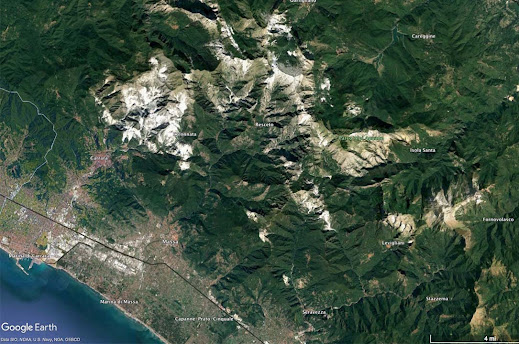Carrara is a coastal region adjacent to a mining district, of the same name, in northwest Italy. The quarries are in the northern-most tip of the Tuscany region, at the northern end of the Apennines Mountains, which form the northwest-southeast trending backbone of the county of Italy. The Apennines intersect the east-west trending Alps, which occur along the northern boundary of Italy. The quarries in the vicinity of the town of Carrara have yielded more marble than any other place on Earth.
A successive- closeup series of three “Google Earth images” showing the Carrara Marble-quarries area [denoted by the red arrows in the first two images].
Marble is a metamorphic rock that forms by heat and pressure applied to the sedimentary rock limestone. The original limestone in the Carrara area was deposited in an epicontinental-platform setting, during the early Jurassic time (almost 200 million years ago). Much later, in Tertiary times, polyphasic tectonic/metamorphic deformation took place and resulted in the fossiliferous limestone being metamorphosed into marble.
The Carrara Marble has been quarried (mined) since the time of Ancient Rome, over 2,000 years (22 centuries ago). Today, there are over 650 marble sites (about half are now abandoned) in the mountain area just east of the town of La Spezia that have extracted this rock from the Earth. Collectively, as shown above, the quarried area is readily recognizable on satellite images. The extensive man-made exposures of the white rock in this area appear as perpetual snow.
The Carrara Marble is world-famous because it is a “statuary marble,” which means it has the texture and durability that sculptors (including the Renaissance sculptor Michelangelo) want(ed) when creating their statues. Statuary marbles are generally whiter with fewer veins, thereby having a more uniform appearance that most marbles, and they are compact with a high quantity of calcium carbonate and a low quantity of silica.
Carrara Marble can be, as mentioned above, 1) pure white (statuario grade—which had a dedicated use for monumental sculpture because it has high tensile strength, can take a super-high gloss and polish, and can hold very fine detail; its supply now depleted since the late 1900’s), or 2) with an attractive, gray veining. Surprisingly, Carrara Marble is affordable (about $2 [in USA currency] per square foot). It is even sold at many home-improvement stores. Also, one should not use acidic liquids nor soap on this marble because they can cause the stone to darken. Carrara Marble can be used for countertops, but it requires proper sealing.
A representative cut and polished slab of Carrara Marble (1 square foot).
Recommended Online Reading/Viewing:
Bonne, K. 2020. Carrara Marble: from the sea to Michelangelo’s workship. Gondwanatalks.com/l/carrara-marble
Stein, C. and E. Sciolino. 2023. State of the Art. Smithsonian Magazine (December issue), pp. 31–41.
Wikipedia, 2023.




No comments:
Post a Comment